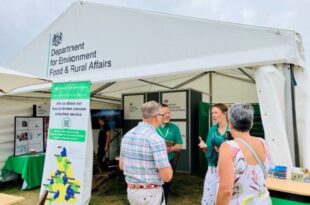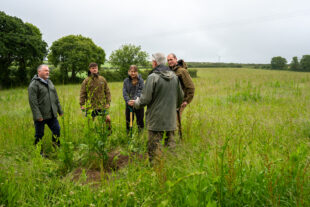https://defrafarming.blog.gov.uk/use-unharvested-low-input-cereal/
Use unharvested low input cereal
The guidance on this page is for SFI pilot participants only. Please visit GOV.UK for the official Sustainable Farming Incentive scheme guidance.
Find out how land managers can help wildlife and rare arable plants by creating unharvested low input cereals.
If you’re completing this action as part of the Sustainable Farming Incentive pilot, how you do it is up to you.
The advice on this page can help you get better environmental and business benefits, but you do not have to follow it to get paid.
Unharvested low input cereal
You should not add fertiliser, insecticide or broad-leaved herbicide to low input cereal. The crop is sown at a lower seed rate than commercial planting to create an open structure. This allows extra space and light which helps rare arable wildflowers to germinate and set seed.
Unharvested low input cereal is left in place until the following spring. If this isn’t possible on your land then you could use harvested low input cereal instead.
Benefits of unharvested low input cereal
You can use unharvested cereal crops to encourage wildlife without removing land from your crop rotation. They provide:
- seeds for farmland birds and small mammals during the autumn and winter
- an insect-rich food source for nesting farmland birds
- pollen and nectar for insects
- space for rare arable wildflowers like cornflower and shepherd’s needle to flower and set seed
- habitat for beneficial predators like ladybirds, ground beetles and hoverflies, which help control problem pests
- a buffer to sensitive habitats like hedgerows and ponds
How to create unharvested low input cereal
You can create unharvested areas as strips or larger plots on a part or whole field basis. Strips should be at least 6 metres wide, as larger areas support a wider range of wildlife.
You can move unharvested cereal crops around your farm as part of your normal arable rotation, or keep them in the same place. Keeping to the same location every year is good if you have rare arable plants, but best avoided if you have weeds that are hard to control.
Choose your location
You can sow unharvested cereal crops on a range of soil types. You’ll find the greatest range of desirable arable plants on light to medium free-draining soils with a history of autumn and spring cropping.
For the best results, consider:
- open, sunny locations, as this will give desirable plants a better chance of growing among the cereal
- sowing near to hedgerows or scrub to provide feeding spots, cover for birds and nest sites for bumblebees
- areas of low soil fertility to minimise the risk of weeds like blackgrass, cleaver and nettle
- field edges, as these often support the greatest range of desirable arable plants
Avoid:
- cool, north-facing shaded locations, as most arable wildflowers will not thrive in these conditions
- locations with perennial and arable grass weed problems, as these will stop arable wildflowers growing
- areas where you have grown oilseed rape, potatoes, beans or peas, as these crops will continue to grow and are difficult to control in a low input cereal crop
- areas where you have grown other reduced herbicide crops, like winter bird food, as this could increase the weed burden
Unharvested low input cereal for corn bunting
Mid-field locations can provide safe nesting and feeding areas for corn bunting.
Plots should be at least 24 metres wide and are best placed next to a flower-rich area on the in-field side.
If you are unable to site these plots next to each other, they should be placed no further than 250 metres apart. This will make sure that adult birds can safely and easily access food.
What to sow
Sow a mix of cereal crops to increase the value of winter feed for birds. Good low input cereal crops include:
- barley
- oats
- rye
- triticale
- wheat
- red or white millet
Avoid maize or sorghum, as they can grow tall and shade out beneficial arable plants.
When to sow
Sow between the beginning of September and the end of April.
You should not establish more than 50% of your yearly unharvested cereal area in autumn.
How to sow
Create an open crop structure. Sow at a rate to produce a plant population of 450 to 700 fertile tillers per square metre. You can achieve this by sowing at 100kg per hectare (kg/ha) on wider than the usual 10-inch row spacings.
Reduce your seed rate if you cannot sow on wider row spacings.
| Sowing date | Maximum seed rate, kg/ha below 10-inch row spacing |
|---|---|
| 1 September to 30 September | 70 |
| 1 October to 31 October | 80 |
| 1 November to 30 November | 90 |
| 1 December to 30 April | 100 |
How to manage unharvested low input cereal
How long to keep the crop
You must keep the unharvested cereal plots in place until mid-February. The plots will provide seeds and cover in the coldest months for farmland birds and other wildlife.
Controlling weeds
If you get a build-up of weeds, rotate the crop around your holding.
To control weeds like spear thistle, dock and ragwort you can:
- spot treat with herbicide using a knapsack sprayer, hand-lance or weed wiper
- remove weeds by hand before they have completed flowering
If this does not work you can top weeds. Only do this as a last resort as it will remove seed heads and can harm wildlife. Top at least 30cm above the ground and no more than 10% of the plot to reduce the risk of harming wildlife.
Using fertiliser
Do not apply lime, organic or inorganic fertilisers. These will encourage a vigorous crop that will shade out arable wildflowers, which are often slower growing and less competitive.
Pest control
Do not apply insecticides between mid-March and harvest, to avoid harming beneficial insects like bees and wasps.
Only use slug pellets as a last resort, to reduce the risk of harm to other wildlife. If you plan to use slug pellets:
- use test baiting to monitor the slug population
- only consider using pellets if there are 4 or more slugs per trap
- consider ferric phosphate-based pellets, which are less toxic to other wildlife
What successful low input cereal looks like
You’ll see:
- a crop with an open structure giving easy access for birds to forage
- sown and wild arable plants producing lots of seeds over winter for birds and small mammals
- bees, butterflies, hoverflies and other pollinators from spring until autumn



